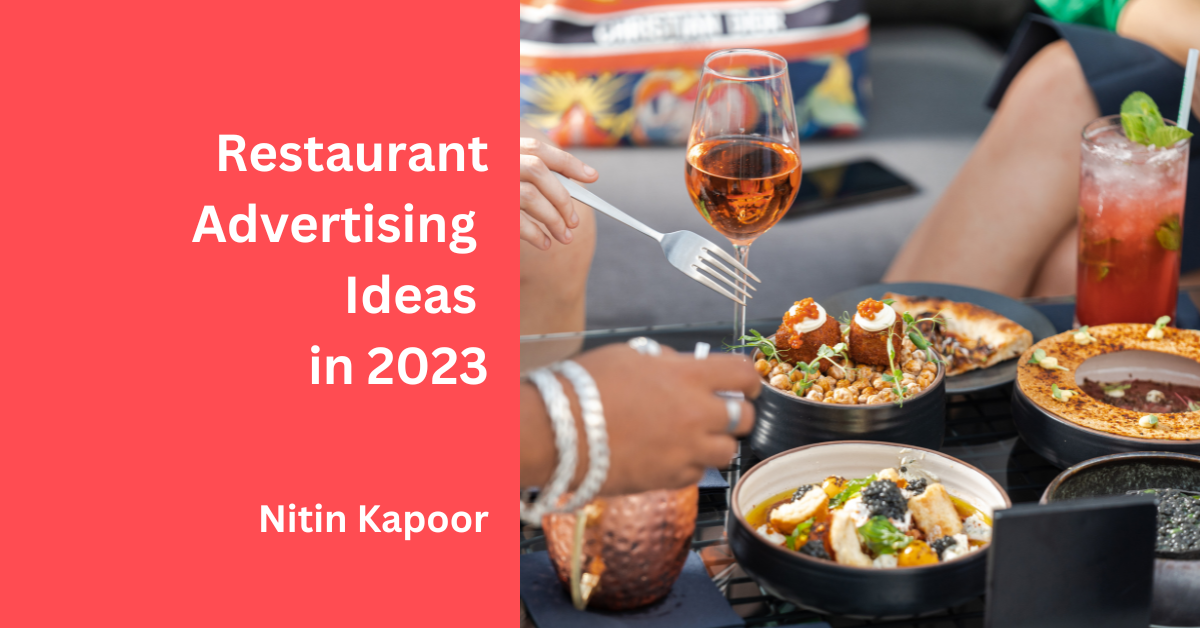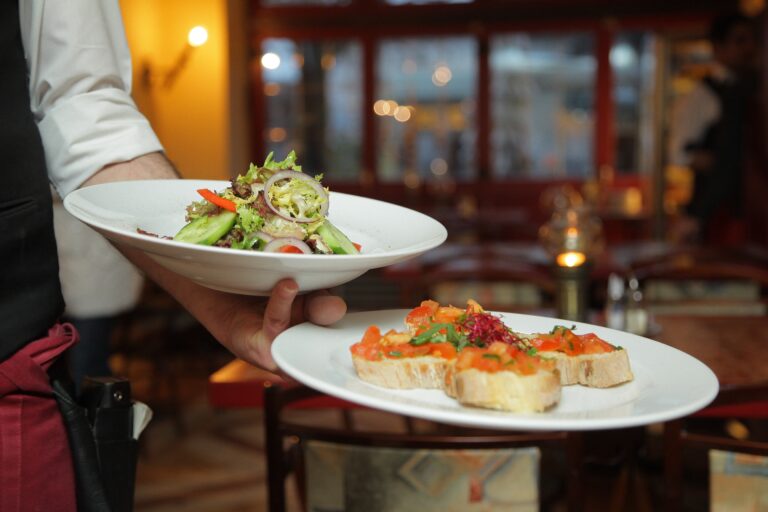Restaurant Advertising Ideas : Paid and Organic Tips for 2023
Restaurant advertising refers to the marketing and promotional activities that restaurants undertake to attract customers and increase their visibility in the competitive foodservice industry. It encompasses a wide range of strategies and techniques to promote a restaurant’s brand, menu, and services to a target audience. Effective restaurant advertising is essential for attracting diners, increasing revenue, and establishing a strong online and offline presence.
When it comes to promoting your restaurant, you have a choice to make: paid advertising or organic advertising. Each option offers unique advantages, and the key is to leverage both to achieve your business goals effectively.
Paid Advertising: Instant Visibility, Controlled Reach
1. Facebook Location Ads:
- Facebook Location Ads are a game-changer. These relatively new ads target people in the vicinity of your restaurant and track whether they see the ad and visit your place. The main call to action is to get directions, making it seamless for potential customers to find you without distractions.
Example: Joe’s Italian Bistro in New York City effectively used Facebook Location Ads to target users within a 2-mile radius. They created enticing ad content showcasing their mouthwatering pasta dishes, and the “Get Directions” button led customers right to their doorstep. This strategy led to a 30% increase in foot traffic within a month.
2. Instagram Ads:
- If you’re not using Instagram ads, you’re missing out on a vast audience. These ads can catapult your restaurant into the spotlight, even if you don’t have a massive following. Just ensure your food looks as enticing in pictures as it does in person.
Example: Sunrise Cafe, a small breakfast spot in San Francisco, ran an Instagram ad campaign featuring their colorful brunch dishes. Despite having a modest Instagram following, the ad reached over 10,000 local users. The result? A 15% increase in weekend brunch reservations.
3. Google Ads (Formerly Adwords):
- Many restaurants underestimate the power of Google Ads, but it’s a goldmine for potential customers. People are constantly searching for restaurants on Google, and with less competition, you can secure clicks at a lower cost.
Example: Taste of India, a family-owned restaurant in Chicago, used Google Ads to target users searching for Indian cuisine in their area. With minimal competition, they achieved a top spot in search results. This resulted in a 20% increase in takeout orders in just two months.
4. Digital Billboards:
- Digital billboards provide a cost-effective approach to pay-per-click advertising. You only pay when your ad is displayed, and you have control over your spending. This innovation combines digital advertising with out-of-home marketing, making it accessible on any budget.
Example: EUR Asia Fusion Sushi, a sushi bar in Houston, adopted digital billboards to increase evening reservations. Their ads featured daily specials and happy hour discounts. With targeted placement near their restaurant, they saw a 25% increase in dine-in customers during happy hour.
Organic Advertising: Free Exposure, Engaging Strategies
5. Word of Mouth – Let Your Customers Be Your Promoters:
- Your customers can be your most effective advertisers. Encourage them to post on Instagram with a unique hashtag related to your restaurant, and offer incentives. It is impossible to overstate the impact of social media sharing.
Example: Sunny Delights Cafe in Miami encouraged customers to share photos with the hashtag #SunnyDelightsEats. In return, they offered a free coffee with any breakfast order. This led to a 40% increase in social media posts featuring their dishes.
6. Search Engine Optimization for Websites:
- Elevate your restaurant’s visibility in search results by investing in SEO. Utilize locality, structured data, and other techniques to enhance your rankings, drawing more patrons to your establishment.
Example: Seafood Cove, a seafood restaurant in Seattle, revamped their website to include location-based keywords and structured data. This move catapulted them to the top of local search results, resulting in a 15% increase in online reservations.
7. Improve Your Online Presence using Local Directories:
- Many potential customers rely on local directories and search engines like Yelp, Google, and Facebook when searching for new dining options. Ensure that your profiles on these platforms are complete and engaging to capture their attention.
Example: Cafe Porto Bello in Boston optimized their profiles on Yelp and Google with mouthwatering photos, updated menus, and glowing customer reviews. This led to a 30% increase in online orders and inquiries.
8. Email Marketing:
- Building a robust email list is a cost-effective way to stay connected with your customers. By sharing relevant content and special offers, you can maintain high open rates and click-through rates, keeping your audience engaged.
Example: Urban Bites, a trendy eatery in San Diego, started an email newsletter with weekly specials and customer stories. Their open rates skyrocketed, with a 20% increase in repeat visits.
9. Social Media Presence: – Engage your customers on various social media platforms, including Facebook, Twitter, Instagram, and Pinterest. Consistent interaction and the sharing of relevant content will help you build a loyal following.
Example: Meat point in Dallas maintained an active presence on social media. They posted daily specials, behind-the-scenes glimpses, and engaged with customers’ comments. This led to a 25% increase in social media followers and a 10% boost in dine-in customers.
10. Participate in Local Events and Fundraisers: – Involvement in local events and fundraisers can expand your restaurant’s visibility and introduce you to a new audience. Consider sponsoring or participating in “Dine and Donate” programs to generate buzz.
Example: The Green Kitchen, a vegetarian restaurant in Portland, sponsored a local “Farmers’ Market Day” to promote healthy eating. They distributed free smoothie samples, and this engagement led to a 50% increase in restaurant visits during the event.
11. Reputation Marketing: – Cultivate a positive online reputation for your restaurant by actively managing and responding to reviews. Your online reputation can be the deciding factor for potential diners, so invest resources in this essential task.
Example: Taste of Tuscany, an Italian eatery in San Antonio, responded promptly to all customer reviews on platforms like Yelp and TripAdvisor. Their strong online reputation resulted in a 40% increase in bookings for special occasions.
12. Loyalty Rewards: – Loyalty marketing is all about nurturing your repeat customers. These loyal patrons often account for a significant portion of your business. Give them something in return for their devotion and encourage them to return.
Example: Gourmet Grub House in Chicago implemented a loyalty program that offered a free dessert for every five visits. This initiative led to a 20% increase in customer retention and a 15% boost in weekly repeat business.
13. Offers & Promotions: – Coupons and special offers have a proven track record of increasing foot traffic to your restaurant. Consider placing incentives in local magazines, newspapers, or direct mail campaigns to draw more customers.
Example: Casa Mia Pizzeria in Los Angeles ran a coupon campaign in a local entertainment magazine. The offer included a free appetizer with any large pizza order. This promotion led to a 30% increase in orders for large pizzas.
14. Four-Walls Marketing: – Concentrate your advertising efforts within a 10-15 mile radius of your restaurant. Leverage your existing customers, employees, and available resources to create a strong local presence.
Example: The Riverside Diner in New Jersey embraced four-walls marketing by involving their staff in promoting the restaurant to locals. They encouraged waitstaff to engage with customers and offer discounts for return visits. This initiative resulted in a 25% increase in weekday lunch traffic.
In the ever-competitive restaurant industry, a well-rounded advertising strategy is essential. Combining paid and organic advertising methods can help you reach a broader audience and grow your restaurant business. If you find online advertising overwhelming, don’t worry; our team specializes in cost-effective online restaurant advertising. Contact us today to create a customized strategy that ensures the best return on investment.






